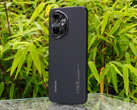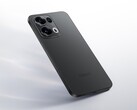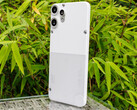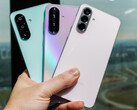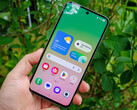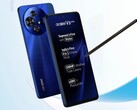Verdict - The powerful mid-range champion with a few weaknesses
The Samsung Galaxy A56 5G offers a balanced total package within the mid-range segment. Its new Exynos processor impresses with good everyday performance and efficiency. Paired with a large battery, the A56 achieves impressive runtimes. Its new design makes the smartphone look a little more unique again, without losing its connection to the Galaxy family. Plus, it's now slimmer, more lightweight, its display can get brighter, and its charging speed has been improved. Last but not least, its update delivery has been extended to six years.
No progress has been made when it comes to its cameras on the back. In this aspect, the competition sometimes has more to offer but all-in-all, Samsung still delivers decent quality. It's a shame that you can no longer use microSD cards, especially since buyers don't have the option to go for a bigger storage configuration. The A56 is also missing 6 GHz WLAN, wireless charging and UWB.
Pros
Cons
Price and availability
You can order the Galaxy A56 5G from major online retailers such as Amazon, where it currently costs $411.35.
Table of Contents
- Verdict - The powerful mid-range champion with a few weaknesses
- Specifications: Samsung Galaxy A56 5G
- Case - The Galaxy A56 relies on Gorilla Glas Victus+ and IP67
- Connectivity - No more microSD for the Galaxy A56
- Software - Android 15 with six years of updates
- Communication and GNSS - Still without 6 GHz WLAN
- Telephone functions and call quality - Dual eSIM on the A56
- Cameras - Now with HDR video
- Accessories and warranty - The Galaxy A56 doesn't come with much
- Input devices and operation - An optical fingerprint scanner on the A56
- Display - The Galaxy A56 with even brighter Super AMOLED
- Performance - The new Exynos 1580 inside the Galaxy A56
- Games - The Samsung phone with HFR gaming
- Emissions - Can get very warm, but remains stable
- Battery life - The Samsung smartphone with 5,000 mAh
- Notebookcheck total rating
- Possible alternatives compared
The Samsung Galaxy A56 5G follows last year's Galaxy A55 5G. Samsung has given its mid-range flagship a whole range of new features. Some are more obvious, like its design, but the A56 has been given updates on the inside, too.
The smartphone is available in two storage configurations: 8/128 GB and 8/256 GB, costing around $370 and $410 respectively. The A56 launched with an MRSP of $499.99, making it cheaper than its predecessor.
Specifications: Samsung Galaxy A56 5G
Case - The Galaxy A56 relies on Gorilla Glas Victus+ and IP67
The Galaxy A56 5G has gotten slightly longer and wider but in turn, it's now slimmer and 15 grams lighter. It comes in the colorways Awesome Lightgray, Olive, Pink and Graphite. Our test device is the latter.
The Samsung phone makes an attractive and high-quality impression thanks to its brushed aluminum frame. Both sides are once again protected by Corning Gorilla Glass Victus+. All gaps are tight and even, and the A56 doesn't succumb to twisting attempts at all. As with its predecessor, the phone is IP67-certified, making it waterproof and dust-tight.
Although its display bezels still aren't the slimmest, they have once again gotten narrower, resulting in an improved display-to-surface ratio of 88%, which is pretty good. The A55 only had 86%.
Connectivity - No more microSD for the Galaxy A56
When it comes to connectivity, the Samsung Galaxy A56 5G is pretty similar to last year's model, however, users now have to do without a microSD card slot. Although this is no longer a rarity within this price class, we would have liked the option to select a larger amount of storage in return.
USB 2.0 is by no means lightning-fast but again, this is the norm within this price class. Its connectivity is rounded out by Wi-Fi 6, NFC and Bluetooth 5.3.
Software - Android 15 with six years of updates
The Galaxy A56 5G comes delivered with Google Android 15 and Samsung's One UI 7.0. Compared to its predecessor, its software support has been extended to six years (until 03/31/2032), which includes security patches as well as OS upgrades.
Unlike the Galaxy S models, Galaxy AI isn't used on this model, but instead, a slimmed-down version of it called Awesome Intelligence. This includes the AI-supported image editing functions Best Face, Auto Trim, the object eraser and the option to create custom image filters. Of course, Gemini and Circle to Search are also on board. However, AI translators and AI agents are not included.
Sustainability
Samsung packages its smartphone in a slim, plastic-free box and has now also done without the foil around the phone's frame. There is no precise information on which recycled raw materials are used for the Galaxy A56, although the CO2e data for the smartphone is provided in Samsung's sustainability report.
As with other models, spare parts and repair instructions are also available for the A56.
Communication and GNSS - Still without 6 GHz WLAN
No progress has been made on the phone's communication module this year. The Galaxy A56 5G supports all the modern cellular standards with a decent frequency band support and during our test in a large city, we had no reception issues.
The phone uses Wi-Fi 6, but still only within the 2.4 and 5.0 GHz frequencies. Together with our Asus ROG Rapture GT-AXE11000 reference router, its transfer rates were stable but could be a little higher.
| Networking | |
| Samsung Galaxy A56 5G | |
| iperf3 transmit AXE11000 | |
| iperf3 receive AXE11000 | |
| Samsung Galaxy A55 5G | |
| iperf3 transmit AXE11000 | |
| iperf3 receive AXE11000 | |
| Xiaomi Redmi Note 14 Pro+ 5G | |
| iperf3 transmit AXE11000 | |
| iperf3 receive AXE11000 | |
| iperf3 transmit AXE11000 6GHz | |
| iperf3 receive AXE11000 6GHz | |
| Apple iPhone 16e | |
| iperf3 transmit AXE11000 | |
| iperf3 receive AXE11000 | |
| Motorola Edge 50 Pro | |
| iperf3 transmit AXE11000 6GHz | |
| iperf3 receive AXE11000 6GHz | |
| Nothing Phone (3a) Pro | |
| iperf3 transmit AXE11000 | |
| iperf3 receive AXE11000 | |
| Average 802.11 a/b/g/n/ac/ax | |
| iperf3 transmit AXE11000 | |
| iperf3 receive AXE11000 | |
| iperf3 transmit AXE11000 6GHz | |
| iperf3 receive AXE11000 6GHz | |
| Average of class Smartphone | |
| iperf3 transmit AXE11000 | |
| iperf3 receive AXE11000 | |
| iperf3 transmit AXE11000 6GHz | |
| iperf3 receive AXE11000 6GHz | |
Despite its single-band connectivity, the smartphone's satellite locating capabilities are super fast and impressively precise. Indoors, it initially takes just a little bit longer, but the Galaxy A56 then takes a while to narrow down its exact location.
We compared the Samsung smartphone with the Garmin Venu 2 fitness smartwatch on a walk. In doing so, the A56 recorded our route well and should be perfectly suitable for navigation tasks.
Telephone functions and call quality - Dual eSIM on the A56
All-in-all, the Samsung Galaxy A56 5G's call quality feels natural during everyday use, whereby most ambient noise is filtered out effectively. In noisier environments, however, the device faces some limitations: Interfering noise can sometimes make it through, leading to the user's voice sounding a little muffled and tinny. But in total, its call quality is good. Using the hands-free mode, voices are transmitted clearly, but they sound a little duller compared to when the phone is held up to your ear.
The Galaxy A56 supports common functions such as WLAN calls (VoWiFi) and VoLTE. Dual-SIM operation is possible using Nano SIM cards as well as eSIMs.
Cameras - Now with HDR video
The Samsung Galaxy A56 5G's front-facing camera has been given a new sensor and although it features a lower resolution than that of its predecessor, it simply takes better photos. Samsung has improved its color balance in particular.
From a hardware standpoint, Samsung hasn't changed anything about the triple-camera on the back and in terms of software, the updates have been kept to a minimum. The phone's main camera takes good photos, but they could be a little more detailed, such as on the Nothing Phone (3a). In low-light conditions, it would surely benefit the shots if they weren't brightened quite as intensely.
The ultra-wide-angle camera does its job pretty well, and the same can be said for the dedicated macro lens. Users can only zoom digitally, and up to a twofold magnification, the photos are still usable. However, zooming in any closer than this makes them appear blurry. It has a maximum digital zoom of 10x (230 mm).
Videos can be recorded using the front-facing camera, the main lens as well as the ultra-wide-angle camera. All three lenses support Ultra HD, Full HD and HD at 30fps; if you want to record at 60fps, then you're limited to the main sensor at 1,080p. Its HDR video support is new and can be used on the front and back.
Image comparison
Choose a scene and navigate within the first image. One click changes the position on touchscreens. One click on the zoomed-in image opens the original in a new window. The first image shows the scaled photograph of the test device.
Main cameraMain cameraUltra-wide angle5x zoomLow-light
In controlled lighting conditions, the Galaxy A56 5G delivered a harmonious color balance without any major outliers.
The phone reproduced our test chart quite well at full resolution and only showed slight sharpness weaknesses in the details, and slightly more noise crept in at the edges.
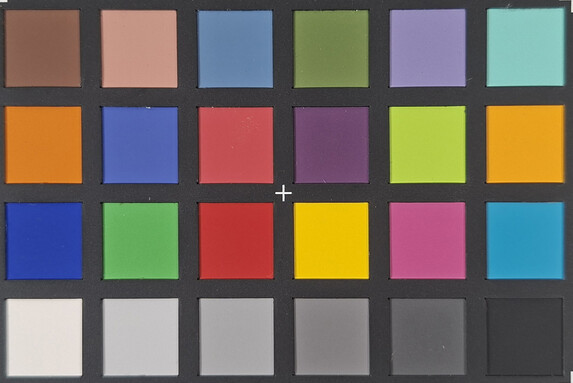

Accessories and warranty - The Galaxy A56 doesn't come with much
The Samsung Galaxy A56 5G's scope of delivery only includes a SIM tool and a USB-C cable. Matching power supplies and cases can be purchased directly from Samsung, but are often cheaper from third-party suppliers.
The cell phone is covered by a standard 12-month warranty, which can be extended via Samsung Care+ and covers damage to the device itself as well as theft. It costs between $129 and $349 for a period lasting 24 months.
Input devices and operation - An optical fingerprint scanner on the A56
The Galaxy A56 5G features a capacitive touchscreen that responds to inputs reliably across the whole panel. There is once again an optical fingerprint scanner installed relatively close to the bottom edge of the display, and it works reliably and recognizes saved prints in no time. Additionally or alternatively, users can select facial recognition via the front-facing camera, which works similarly reliably in good lighting conditions, but is less secure.
Samsung has again transformed its power button into a function button, which can be customized by users to fit their individual needs. By default, double-tapping the button opens the camera and if you hold it down, Bixby is launched.
The phone still supports functions such as dual-messenger and a one-handed mode. The linear vibration motor can be customized within the phone's settings and is very quiet, while still being precise and perceptible.
Display - The Galaxy A56 with even brighter Super AMOLED
Compared to the predecessor model, the Samsung Galaxy A56 5G's display has grown a tiny bit to 6.7 inches (17.02 centimeters). As its resolution has remained the same, its pixel density is now a little lower but even so, the picture still looks extremely sharp.
Samsung has once again improved the brightness of its Super AMOLED panel and it boasts an even illumination. While the panel reaches a brightness of just under 1,200 cd/m² when depicting a full white surface, it rises to up to 2,001 cd/m² when showing smaller white excerpts.
The OLED display flickers at a frequency of up to 240 Hz but has a flat amplitude and an eye-comfort mode which reduces blue light. Even so, due to its low frequency, sensitive users may still experience some complaints.
| |||||||||||||||||||||||||
Brightness Distribution: 99 %
Center on Battery: 1184 cd/m²
Contrast: ∞:1 (Black: 0 cd/m²)
ΔE ColorChecker Calman: 1.7 | ∀{0.5-29.43 Ø4.78}
ΔE Greyscale Calman: 2.4 | ∀{0.09-98 Ø5}
99.1% sRGB (Calman 2D)
Gamma: 2.12
CCT: 6544 K
| Samsung Galaxy A56 5G Super AMOLED, 2340x1080, 6.7" | Samsung Galaxy A55 5G Super AMOLED, 2340x1080, 6.6" | Xiaomi Redmi Note 14 Pro+ 5G AMOLED, 2712x1220, 6.7" | Apple iPhone 16e OLED, 2532x1170, 6.1" | Motorola Edge 50 Pro P-OLED, 2712x1220, 6.7" | Nothing Phone (3a) Pro AMOLED, 2392x1080, 6.8" | |
|---|---|---|---|---|---|---|
| Screen | 4% | 16% | 21% | 6% | 8% | |
| Brightness middle (cd/m²) | 1184 | 962 -19% | 1210 2% | 833 -30% | 1064 -10% | 1318 11% |
| Brightness (cd/m²) | 1179 | 967 -18% | 1222 4% | 837 -29% | 1038 -12% | 1306 11% |
| Brightness Distribution (%) | 99 | 99 0% | 92 -7% | 99 0% | 88 -11% | 98 -1% |
| Black Level * (cd/m²) | ||||||
| Colorchecker dE 2000 * | 1.7 | 1.6 6% | 1 41% | 0.7 59% | 1.17 31% | 1.5 12% |
| Colorchecker dE 2000 max. * | 3.2 | 2.6 19% | 2.7 16% | 1.6 50% | 2.47 23% | 2.9 9% |
| Greyscale dE 2000 * | 2.4 | 1.5 37% | 1.5 37% | 0.6 75% | 2 17% | 2.3 4% |
| Gamma | 2.12 104% | 2.13 103% | 2.25 98% | 2.19 100% | 2.238 98% | 2.26 97% |
| CCT | 6544 99% | 6382 102% | 6509 100% | 6525 100% | 6423 101% | 6819 95% |
* ... smaller is better
| Display / APL18 Peak Brightness | |
| Samsung Galaxy A56 5G | |
| Samsung Galaxy A55 5G | |
| Nothing Phone (3a) Pro | |
| Xiaomi Redmi Note 14 Pro+ 5G | |
| Apple iPhone 16e | |
| Display / HDR Peak Brightness | |
| Xiaomi Redmi Note 14 Pro+ 5G | |
| Samsung Galaxy A56 5G | |
| Samsung Galaxy A55 5G | |
| Nothing Phone (3a) Pro | |
| Apple iPhone 16e | |
Screen Flickering / PWM (Pulse-Width Modulation)
| Screen flickering / PWM detected | 120 Hz Amplitude: 14.29 % Secondary Frequency: 240 Hz | ||
The display backlight flickers at 120 Hz (worst case, e.g., utilizing PWM) . The frequency of 120 Hz is very low, so the flickering may cause eyestrain and headaches after extended use. In comparison: 53 % of all tested devices do not use PWM to dim the display. If PWM was detected, an average of 8091 (minimum: 5 - maximum: 343500) Hz was measured. | |||
Measurement series with fixed zoom level and different brightness settings (The amplitude curve at minimum brightness looks flat, but this is due to the scaling. The info box shows the enlarged version of the amplitude at minimum brightness).
We measured how accurately the Galaxy A56 reproduces colors using a photo spectrometer and the Calman analysis software. We noted the best results with the profile Natural selected.
Its white balance skews a little towards green, but you shouldn't notice this during everyday use. Colors and grayscale are both depicted accurately, however, the competition shows that even more can be done.
Display Response Times
| ↔ Response Time Black to White | ||
|---|---|---|
| 1.2 ms ... rise ↗ and fall ↘ combined | ↗ 0.616 ms rise | |
| ↘ 0.581 ms fall | ||
| The screen shows very fast response rates in our tests and should be very well suited for fast-paced gaming. In comparison, all tested devices range from 0.1 (minimum) to 240 (maximum) ms. » 5 % of all devices are better. This means that the measured response time is better than the average of all tested devices (20.2 ms). | ||
| ↔ Response Time 50% Grey to 80% Grey | ||
| 1.15 ms ... rise ↗ and fall ↘ combined | ↗ 0.5805 ms rise | |
| ↘ 0.565 ms fall | ||
| The screen shows very fast response rates in our tests and should be very well suited for fast-paced gaming. In comparison, all tested devices range from 0.165 (minimum) to 636 (maximum) ms. » 4 % of all devices are better. This means that the measured response time is better than the average of all tested devices (31.6 ms). | ||
Performance - The new Exynos 1580 inside the Galaxy A56
The Galaxy A56 is powered by Samsung's own Exynos 1580 with 8 GB LPDDR5 RAM, which uses more modern Cortex cores compared to its predecessor and as a result, it achieves a higher CPU performance.
Within the comparison field, the SoC was clearly ahead of most competitors during our test, but it couldn't hold a candle to the iPhone 16e's Apple A18 or the Pixel 9a's Tensor G4.
| UL Procyon AI Inference for Android - Overall Score NNAPI | |
| Average of class Smartphone (3769 - 81594, n=134, last 2 years) | |
| Samsung Galaxy A56 5G | |
| Average Samsung Exynos 1580 (10372 - 11181, n=3) | |
| Motorola Edge 50 Pro | |
| Nothing Phone (3a) Pro | |
| Xiaomi Redmi Note 14 Pro+ 5G | |
| Samsung Galaxy A55 5G | |
Graphics calculations are performed by the integrated Xclipse 540, which offers a noticeable increase in performance compared to last year's model, but still doesn't support ray tracing.
GFXBench (DX / GLBenchmark) 2.7: T-Rex Onscreen | 1920x1080 T-Rex Offscreen
GFXBench 3.0: on screen Manhattan Onscreen OGL | 1920x1080 1080p Manhattan Offscreen
GFXBench 3.1: on screen Manhattan ES 3.1 Onscreen | 1920x1080 Manhattan ES 3.1 Offscreen
GFXBench: on screen Car Chase Onscreen | 1920x1080 Car Chase Offscreen | on screen Aztec Ruins High Tier Onscreen | 2560x1440 Aztec Ruins High Tier Offscreen | on screen Aztec Ruins Normal Tier Onscreen | 1920x1080 Aztec Ruins Normal Tier Offscreen | 3840x2160 4K Aztec Ruins High Tier Offscreen
| 3DMark / Wild Life Extreme Unlimited | |
| Apple iPhone 16e | |
| Motorola Edge 50 Pro | |
| Samsung Galaxy A56 5G | |
| Nothing Phone (3a) Pro | |
| Xiaomi Redmi Note 14 Pro+ 5G | |
| Samsung Galaxy A55 5G | |
| 3DMark / Wild Life Extreme | |
| Apple iPhone 16e | |
| Motorola Edge 50 Pro | |
| Samsung Galaxy A56 5G | |
| Nothing Phone (3a) Pro | |
| Xiaomi Redmi Note 14 Pro+ 5G | |
| Samsung Galaxy A55 5G | |
| 3DMark / Wild Life Unlimited Score | |
| Apple iPhone 16e | |
| Motorola Edge 50 Pro | |
| Samsung Galaxy A56 5G | |
| Nothing Phone (3a) Pro | |
| Xiaomi Redmi Note 14 Pro+ 5G | |
| Samsung Galaxy A55 5G | |
| 3DMark / Steel Nomad Light Unlimited Score | |
| Apple iPhone 16e | |
| Samsung Galaxy A56 5G | |
| Nothing Phone (3a) Pro | |
| Xiaomi Redmi Note 14 Pro+ 5G | |
| 3DMark / Steel Nomad Light Score | |
| Apple iPhone 16e | |
| Samsung Galaxy A56 5G | |
| Nothing Phone (3a) Pro | |
| Xiaomi Redmi Note 14 Pro+ 5G | |
| GFXBench (DX / GLBenchmark) 2.7 / T-Rex Onscreen | |
| Motorola Edge 50 Pro | |
| Samsung Galaxy A56 5G | |
| Samsung Galaxy A55 5G | |
| Xiaomi Redmi Note 14 Pro+ 5G | |
| Apple iPhone 16e | |
| Nothing Phone (3a) Pro | |
| GFXBench (DX / GLBenchmark) 2.7 / T-Rex Offscreen | |
| Apple iPhone 16e | |
| Motorola Edge 50 Pro | |
| Samsung Galaxy A56 5G | |
| Samsung Galaxy A55 5G | |
| Xiaomi Redmi Note 14 Pro+ 5G | |
| Nothing Phone (3a) Pro | |
| GFXBench 3.0 / Manhattan Onscreen OGL | |
| Samsung Galaxy A56 5G | |
| Samsung Galaxy A55 5G | |
| Motorola Edge 50 Pro | |
| Apple iPhone 16e | |
| Nothing Phone (3a) Pro | |
| Xiaomi Redmi Note 14 Pro+ 5G | |
| GFXBench 3.0 / 1080p Manhattan Offscreen | |
| Apple iPhone 16e | |
| Samsung Galaxy A56 5G | |
| Motorola Edge 50 Pro | |
| Samsung Galaxy A55 5G | |
| Nothing Phone (3a) Pro | |
| Xiaomi Redmi Note 14 Pro+ 5G | |
| GFXBench 3.1 / Manhattan ES 3.1 Onscreen | |
| Samsung Galaxy A56 5G | |
| Apple iPhone 16e | |
| Motorola Edge 50 Pro | |
| Samsung Galaxy A55 5G | |
| Nothing Phone (3a) Pro | |
| Xiaomi Redmi Note 14 Pro+ 5G | |
| GFXBench 3.1 / Manhattan ES 3.1 Offscreen | |
| Apple iPhone 16e | |
| Samsung Galaxy A56 5G | |
| Motorola Edge 50 Pro | |
| Samsung Galaxy A55 5G | |
| Nothing Phone (3a) Pro | |
| Xiaomi Redmi Note 14 Pro+ 5G | |
| GFXBench / Car Chase Onscreen | |
| Apple iPhone 16e | |
| Samsung Galaxy A56 5G | |
| Samsung Galaxy A55 5G | |
| Motorola Edge 50 Pro | |
| Nothing Phone (3a) Pro | |
| Xiaomi Redmi Note 14 Pro+ 5G | |
| GFXBench / Car Chase Offscreen | |
| Apple iPhone 16e | |
| Samsung Galaxy A56 5G | |
| Samsung Galaxy A55 5G | |
| Nothing Phone (3a) Pro | |
| Xiaomi Redmi Note 14 Pro+ 5G | |
| GFXBench / Aztec Ruins High Tier Onscreen | |
| Apple iPhone 16e | |
| Samsung Galaxy A56 5G | |
| Nothing Phone (3a) Pro | |
| Samsung Galaxy A55 5G | |
| Motorola Edge 50 Pro | |
| Xiaomi Redmi Note 14 Pro+ 5G | |
| GFXBench / Aztec Ruins High Tier Offscreen | |
| Apple iPhone 16e | |
| Samsung Galaxy A56 5G | |
| Motorola Edge 50 Pro | |
| Xiaomi Redmi Note 14 Pro+ 5G | |
| Nothing Phone (3a) Pro | |
| Samsung Galaxy A55 5G | |
| GFXBench / Aztec Ruins Normal Tier Onscreen | |
| Apple iPhone 16e | |
| Samsung Galaxy A56 5G | |
| Nothing Phone (3a) Pro | |
| Samsung Galaxy A55 5G | |
| Motorola Edge 50 Pro | |
| Xiaomi Redmi Note 14 Pro+ 5G | |
| GFXBench / Aztec Ruins Normal Tier Offscreen | |
| Apple iPhone 16e | |
| Samsung Galaxy A56 5G | |
| Motorola Edge 50 Pro | |
| Xiaomi Redmi Note 14 Pro+ 5G | |
| Nothing Phone (3a) Pro | |
| Samsung Galaxy A55 5G | |
| GFXBench / 4K Aztec Ruins High Tier Offscreen | |
| Apple iPhone 16e | |
| Samsung Galaxy A56 5G | |
| Motorola Edge 50 Pro | |
| Xiaomi Redmi Note 14 Pro+ 5G | |
| Nothing Phone (3a) Pro | |
| Samsung Galaxy A55 5G | |
Surfing the web is quick and easy on the Galaxy A56. During the benchmarks, it was always at the top of the comparison field compared to its rivals; only the iPhone 16e was in a class of its own in this respect.
| Jetstream 2 - 2.0 Total Score | |
| Apple iPhone 16e (Safari 18) | |
| Average of class Smartphone (23.8 - 387, n=148, last 2 years) | |
| Average Samsung Exynos 1580 (n=1) | |
| Samsung Galaxy A56 5G (Chrome 134) | |
| Nothing Phone (3a) Pro (chrome 134) | |
| Samsung Galaxy A55 5G (Chrome 123) | |
| Motorola Edge 50 Pro (Chrome 124) | |
| Xiaomi Redmi Note 14 Pro+ 5G (Chrome 132) | |
| Speedometer 2.0 - Result 2.0 | |
| Apple iPhone 16e (Safari 18) | |
| Average of class Smartphone (15.2 - 643, n=121, last 2 years) | |
| Average Samsung Exynos 1580 (191 - 194, n=2) | |
| Samsung Galaxy A56 5G (Chrome 134) | |
| Nothing Phone (3a) Pro (chrome 135) | |
| Motorola Edge 50 Pro (Chrome 124) | |
| Xiaomi Redmi Note 14 Pro+ 5G (Chrome 132) | |
| Samsung Galaxy A55 5G (Chrome 123) | |
| Speedometer 3 - Score 3.0 | |
| Apple iPhone 16e (Safari 18) | |
| Average of class Smartphone (1.03 - 42.8, n=124, last 2 years) | |
| Average Samsung Exynos 1580 (12 - 12.3, n=3) | |
| Samsung Galaxy A56 5G (Chrome 134) | |
| Nothing Phone (3a) Pro (chrome 135) | |
| Xiaomi Redmi Note 14 Pro+ 5G (Chrome 132) | |
| Motorola Edge 50 Pro (Chrome 124) | |
| Samsung Galaxy A55 5G (Chrome 123) | |
| WebXPRT 4 - Overall | |
| Apple iPhone 16e (Safari 18) | |
| Average of class Smartphone (27 - 306, n=144, last 2 years) | |
| Average Samsung Exynos 1580 (138 - 144, n=3) | |
| Samsung Galaxy A56 5G (Chrome 134) | |
| Samsung Galaxy A55 5G (Chrome 123) | |
| Nothing Phone (3a) Pro (chrome 134) | |
| Xiaomi Redmi Note 14 Pro+ 5G (Chrome 132) | |
| Motorola Edge 50 Pro (Chrome 124) | |
| Octane V2 - Total Score | |
| Apple iPhone 16e (Safari 18) | |
| Samsung Galaxy A56 5G (Chrome 134) | |
| Average Samsung Exynos 1580 (49327 - 50864, n=3) | |
| Average of class Smartphone (2228 - 121337, n=195, last 2 years) | |
| Nothing Phone (3a) Pro (chrome 134) | |
| Samsung Galaxy A55 5G (Chrome 123) | |
| Motorola Edge 50 Pro (Chrome 124) | |
| Xiaomi Redmi Note 14 Pro+ 5G (Chrome 132) | |
| Mozilla Kraken 1.1 - Total | |
| Motorola Edge 50 Pro (Chrome 124) | |
| Average of class Smartphone (257 - 28190, n=154, last 2 years) | |
| Xiaomi Redmi Note 14 Pro+ 5G (Chrome 132) | |
| Samsung Galaxy A55 5G (Chrome 123) | |
| Nothing Phone (3a) Pro (chrome 134) | |
| Average Samsung Exynos 1580 (791 - 851, n=3) | |
| Samsung Galaxy A56 5G (Chrome 134) | |
| Apple iPhone 16e (Safari 18) | |
* ... smaller is better
Samsung has improved the write rates of its UFS 3.1 storage compared to the predecessor model, even if the Galaxy A56 still can't fully exploit the possibilities of this fast storage.
| Samsung Galaxy A56 5G | Samsung Galaxy A55 5G | Xiaomi Redmi Note 14 Pro+ 5G | Motorola Edge 50 Pro | Nothing Phone (3a) Pro | Average 128 GB UFS 3.1 Flash | Average of class Smartphone | |
|---|---|---|---|---|---|---|---|
| AndroBench 3-5 | 7% | -16% | 35% | 12% | 6% | 63% | |
| Sequential Read 256KB (MB/s) | 1634.8 | 1688.53 3% | 992.72 -39% | 1023.6 -37% | 996.23 -39% | 1569 ? -4% | 2243 ? 37% |
| Sequential Write 256KB (MB/s) | 999.95 | 831.44 -17% | 931.68 -7% | 1025.9 3% | 970.63 -3% | 768 ? -23% | 1865 ? 87% |
| Random Read 4KB (MB/s) | 207.01 | 351.47 70% | 171.2 -17% | 337 63% | 255.89 24% | 244 ? 18% | 296 ? 43% |
| Random Write 4KB (MB/s) | 184.08 | 132.11 -28% | 186.14 1% | 390.2 112% | 304.95 66% | 243 ? 32% | 339 ? 84% |
Games - The Samsung phone with HFR gaming
We analyzed the Samsung Galaxy A56 5G's gaming capabilities with the help of GameBench. From all the games we tested, older ones, such as Dead Trigger 2, can be played at up to 120fps.
For graphically demanding titles, you'll have to reduce the detail level to ensure a smooth display. Although it looked mostly smooth during our test, we repeatedly noticed some small stutters and the smartphone got very warm. The highest detail mode isn't even available for PUBG Mobile.
Emissions - Can get very warm, but remains stable
Temperature
During our test, its surface temperatures rose to 49 °C in places under continuous load, which we simulated using the Burnout benchmark. Although this is comparatively high, it's still within acceptable limits.
On the other hand, Samsung seems to manage to dissipate the heat from its SoC well, as it was largely unimpressed by the stress tests.
(-) The maximum temperature on the upper side is 48.5 °C / 119 F, compared to the average of 35.2 °C / 95 F, ranging from 21.9 to 247 °C for the class Smartphone.
(-) The bottom heats up to a maximum of 49 °C / 120 F, compared to the average of 34 °C / 93 F
(+) In idle usage, the average temperature for the upper side is 27.2 °C / 81 F, compared to the device average of 32.9 °C / 91 F.
3DMark stress tests
| 3DMark | |
| Wild Life Stress Test Stability | |
| Samsung Galaxy A55 5G | |
| Nothing Phone (3a) Pro | |
| Samsung Galaxy A56 5G | |
| Xiaomi Redmi Note 14 Pro+ 5G | |
| Motorola Edge 50 Pro | |
| Apple iPhone 16e | |
| Wild Life Extreme Stress Test | |
| Nothing Phone (3a) Pro | |
| Samsung Galaxy A55 5G | |
| Motorola Edge 50 Pro | |
| Samsung Galaxy A56 5G | |
| Xiaomi Redmi Note 14 Pro+ 5G | |
| Apple iPhone 16e | |
| Steel Nomad Light Stress Test Stability | |
| Nothing Phone (3a) Pro | |
| Xiaomi Redmi Note 14 Pro+ 5G | |
| Samsung Galaxy A56 5G | |
| Apple iPhone 16e | |
Speakers
The Galaxy A56's two speakers deliver a rather average audio experience, which primarily makes itself known at full volume, where the low frequencies sound a little weak and the super high tones are barely audible.
USB-C can be used for wired audio output. Bluetooth is available wirelessly with a limited range of audio codecs. Auracast is supported by the Galaxy A56.
Samsung Galaxy A56 5G audio analysis
(+) | speakers can play relatively loud (87.7 dB)
Bass 100 - 315 Hz
(-) | nearly no bass - on average 22.3% lower than median
(±) | linearity of bass is average (8.1% delta to prev. frequency)
Mids 400 - 2000 Hz
(±) | higher mids - on average 5.1% higher than median
(+) | mids are linear (5.8% delta to prev. frequency)
Highs 2 - 16 kHz
(±) | higher highs - on average 8% higher than median
(+) | highs are linear (5.5% delta to prev. frequency)
Overall 100 - 16.000 Hz
(±) | linearity of overall sound is average (20.5% difference to median)
Compared to same class
» 35% of all tested devices in this class were better, 9% similar, 56% worse
» The best had a delta of 11%, average was 35%, worst was 134%
Compared to all devices tested
» 54% of all tested devices were better, 8% similar, 39% worse
» The best had a delta of 4%, average was 24%, worst was 134%
Xiaomi Redmi Note 14 Pro+ 5G audio analysis
(+) | speakers can play relatively loud (90.6 dB)
Bass 100 - 315 Hz
(-) | nearly no bass - on average 25.6% lower than median
(±) | linearity of bass is average (7.7% delta to prev. frequency)
Mids 400 - 2000 Hz
(±) | reduced mids - on average 5% lower than median
(+) | mids are linear (4.5% delta to prev. frequency)
Highs 2 - 16 kHz
(+) | balanced highs - only 3.1% away from median
(+) | highs are linear (4.4% delta to prev. frequency)
Overall 100 - 16.000 Hz
(±) | linearity of overall sound is average (16.6% difference to median)
Compared to same class
» 8% of all tested devices in this class were better, 5% similar, 87% worse
» The best had a delta of 11%, average was 35%, worst was 134%
Compared to all devices tested
» 28% of all tested devices were better, 6% similar, 66% worse
» The best had a delta of 4%, average was 24%, worst was 134%
Battery life - The Samsung smartphone with 5,000 mAh
Power consumption
Samsung has improved the power consumption of the Galaxy A56 in idle mode, but it is quite high under load.
Wired, the Samsung smartphone charges at up to 45 watts, which is nominally faster than the Galaxy S25 (25 watts, 4,000 mAh). However, this makes no difference in everyday use due to the A56's larger battery. While the S25 needed 70 minutes to fully charge its battery during our test, the A56 needed 71 minutes (50%: 21 mins, 80%: 38 mins, 90%: 48 mins). Compared to the A55, on the other hand, its charging time has been reduced by 12 minutes. The mid-range smartphone doesn't support wireless charging.
| Off / Standby | |
| Idle | |
| Load |
|
Key:
min: | |
| Samsung Galaxy A56 5G 5000 mAh | Samsung Galaxy A55 5G 5000 mAh | Xiaomi Redmi Note 14 Pro+ 5G 5110 mAh | Apple iPhone 16e 4005 mAh | Motorola Edge 50 Pro 4500 mAh | Nothing Phone (3a) Pro 5000 mAh | Average Samsung Exynos 1580 | Average of class Smartphone | |
|---|---|---|---|---|---|---|---|---|
| Power Consumption | 5% | 17% | 8% | 16% | 25% | -67% | 4% | |
| Idle Minimum * (Watt) | 0.72 | 0.85 -18% | 1.07 -49% | 0.68 6% | 0.9 -25% | 0.89 -24% | 1.337 ? -86% | 0.845 ? -17% |
| Idle Average * (Watt) | 1.45 | 1.51 -4% | 1.26 13% | 1.89 -30% | 1.3 10% | 1.3 10% | 3.34 ? -130% | 1.44 ? 1% |
| Idle Maximum * (Watt) | 1.49 | 1.71 -15% | 1.28 14% | 1.93 -30% | 1.6 -7% | 1.33 11% | 3.49 ? -134% | 1.625 ? -9% |
| Load Average * (Watt) | 9.68 | 4.87 50% | 3.7 62% | 3.77 61% | 4.8 50% | 3.29 66% | 8.98 ? 7% | 7.01 ? 28% |
| Load Maximum * (Watt) | 13.39 | 11.73 12% | 7.52 44% | 9.04 32% | 6.7 50% | 4.76 64% | 12.3 ? 8% | 11.3 ? 16% |
* ... smaller is better
Power consumption: Geekbench (150 cd/m²)
Power consumption: GFXbench (150 cd/m²)
Runtimes
The Samsung Galaxy A56 5G delivered a surprise in terms of its battery life, lasting significantly longer during most of our tests. As expected, its runtimes were somewhat shorter under load.
| Samsung Galaxy A56 5G 5000 mAh | Samsung Galaxy A55 5G 5000 mAh | Xiaomi Redmi Note 14 Pro+ 5G 5110 mAh | Apple iPhone 16e 4005 mAh | Motorola Edge 50 Pro 4500 mAh | Nothing Phone (3a) Pro 5000 mAh | |
|---|---|---|---|---|---|---|
| Battery runtime | -20% | -24% | -6% | -19% | -1% | |
| Reader / Idle (h) | 52.9 | 36.7 -31% | 23.9 -55% | 47.4 -10% | 31.6 -40% | |
| H.264 (h) | 41.8 | 25.2 -40% | 18.5 -56% | 24.3 -42% | 18.7 -55% | |
| WiFi v1.3 (h) | 20 | 18 -10% | 19.5 -2% | 23.2 16% | 16.3 -18% | 19.8 -1% |
| Load (h) | 3.6 | 3.7 3% | 4.2 17% | 4.1 14% | 5 39% |
Notebookcheck total rating
The Samsung Galaxy A56 5G is a powerful mid-range smartphone that may not set the best standards in its class in all areas, but it does offer a good overall package.
Samsung Galaxy A56 5G
- 05/20/2025 v8
Daniel Schmidt
Possible alternatives compared
Image | Model / Review | Price | Weight | Drive | Display |
|---|---|---|---|---|---|
| Samsung Galaxy A56 5G Samsung Exynos 1580 ⎘ Samsung Xclipse 540 ⎘ 8 GB Memory, 128 GB | Amazon: 1. $369.90 Samsung Galaxy A56 5G 2025 |... 2. $399.99 Samsung Galaxy A56 5G Cell P... 3. $349.99 Samsung Galaxy A56 5G 2025 |... List Price: 479€ | 198 g | 128 GB UFS 3.1 Flash | 6.70" 2340x1080 385 PPI Super AMOLED | |
| Xiaomi Redmi Note 14 Pro+ 5G Qualcomm Snapdragon 7s Gen 3 ⎘ Qualcomm Adreno 810 ⎘ 12 GB Memory, 512 GB UFS 2.1 | Amazon: 1. $347.50 XIAOMI Redmi Note 14 Pro+ Pl... 2. $309.99 Xiaomi Redmi Note 14 Pro 5G ... 3. $377.99 XIAOMI Redmi Note 14 Pro+ Pl... List Price: 530€ | 205 g | 512 GB UFS 2.2 Flash | 6.67" 2712x1220 446 PPI AMOLED | |
| Apple iPhone 16e Apple A18 ⎘ Apple A18 GPU ⎘ 8 GB Memory, 128 GB NVMe | Amazon: 1. $5.98 Ailun Screen Protector for i... 2. $9.99 SPIDERCASE Designed for iPho... 3. $6.99 TAURI for iPhone 16e Case, C... List Price: 699 Euro | 167 g | 128 GB NVMe | 6.10" 2532x1170 460 PPI OLED | |
| Motorola Edge 50 Pro Qualcomm Snapdragon 7 Gen 3 ⎘ Qualcomm Adreno 720 ⎘ 12 GB Memory, 512 GB UFS 2.1 | Amazon: 1. $599.98 Motorola Moto Edge 60 Pro 5G... 2. $549.99 Motorola Moto Edge 50 Pro 5G... 3. $7.99 POHYPYZ 3 Pack Screen Protec... List Price: 699€ | 186 g | 512 GB UFS 2.2 Flash | 6.70" 2712x1220 444 PPI P-OLED | |
| Nothing Phone (3a) Pro Qualcomm Snapdragon 7s Gen 3 ⎘ Qualcomm Adreno 810 ⎘ 12 GB Memory | Amazon: 1. $6.99 JETech Screen Protector for ... 2. $4.99 Fhyeugfy for Nothing Phone (... 3. $11.99 Ibywind For Nothing Phone (3... | 211 g | 6.77" 2392x1080 388 PPI AMOLED |
Transparency
The selection of devices to be reviewed is made by our editorial team. The test sample was provided to the author as a loan by the manufacturer or retailer for the purpose of this review. The lender had no influence on this review, nor did the manufacturer receive a copy of this review before publication. There was no obligation to publish this review. As an independent media company, Notebookcheck is not subjected to the authority of manufacturers, retailers or publishers.
This is how Notebookcheck is testing
Every year, Notebookcheck independently reviews hundreds of laptops and smartphones using standardized procedures to ensure that all results are comparable. We have continuously developed our test methods for around 20 years and set industry standards in the process. In our test labs, high-quality measuring equipment is utilized by experienced technicians and editors. These tests involve a multi-stage validation process. Our complex rating system is based on hundreds of well-founded measurements and benchmarks, which maintains objectivity. Further information on our test methods can be found here.




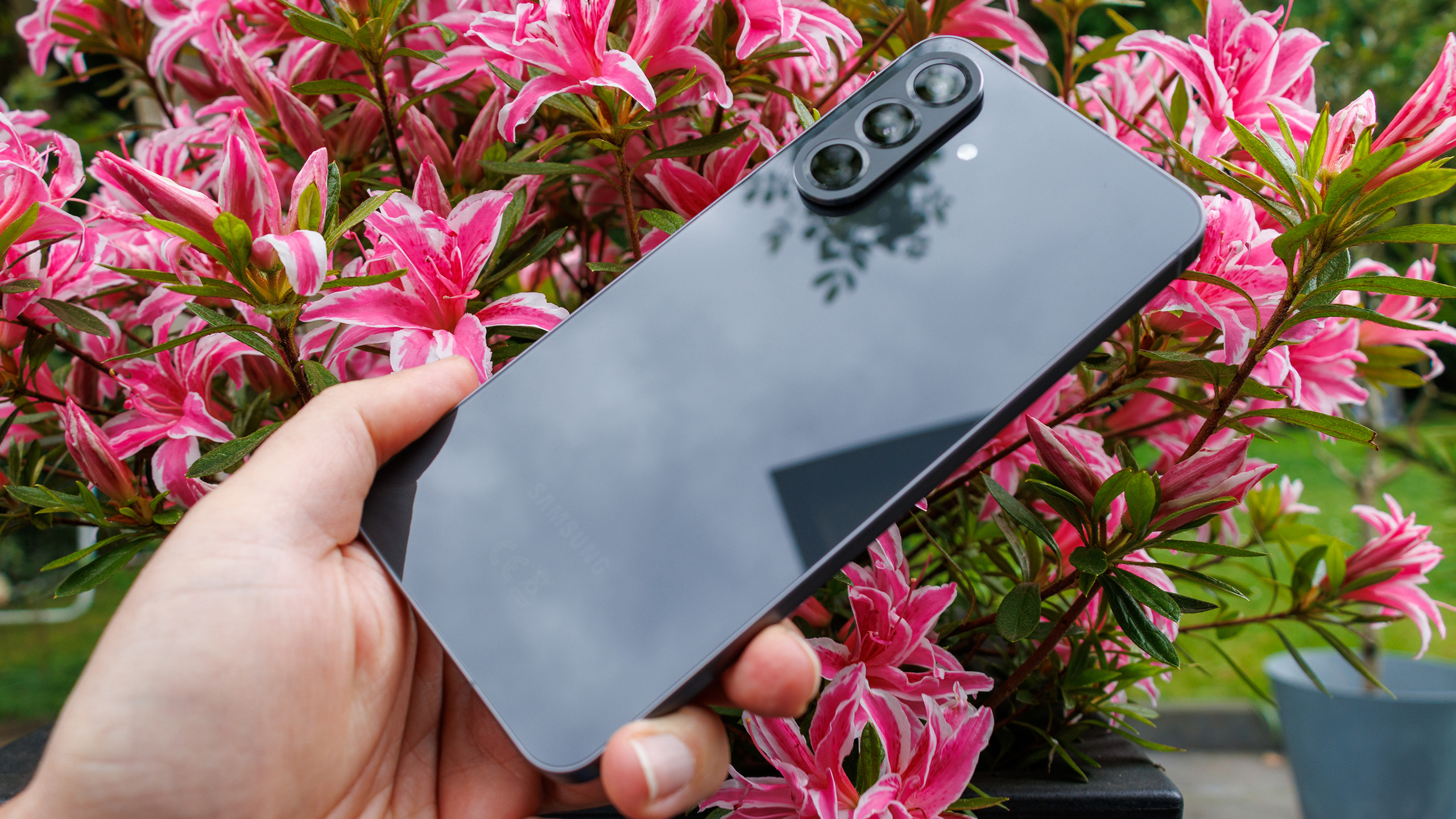
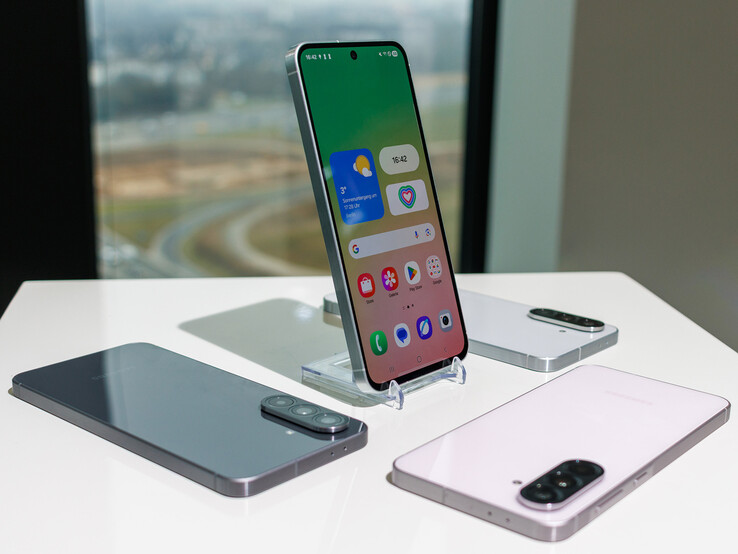












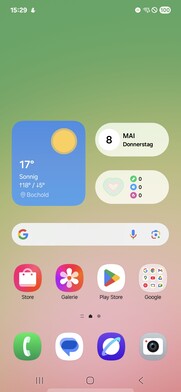
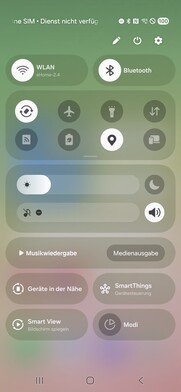
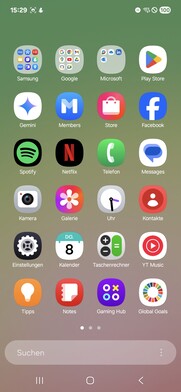

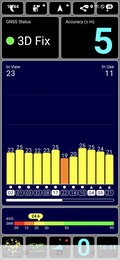
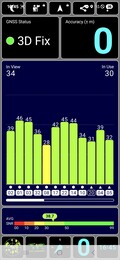


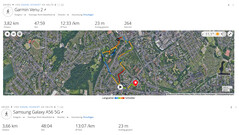

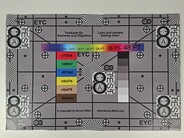

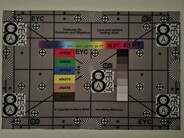


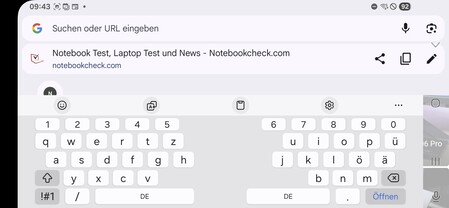




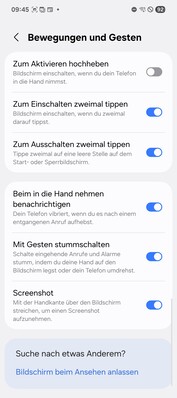

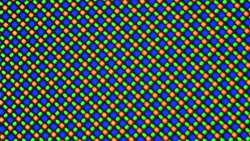
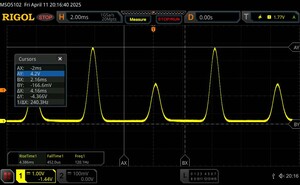





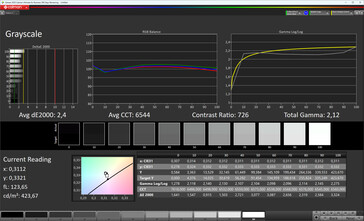
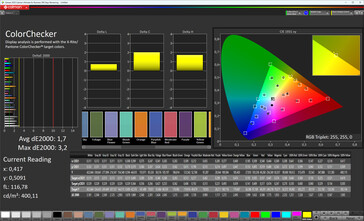

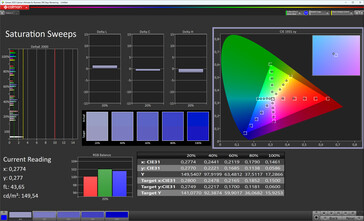
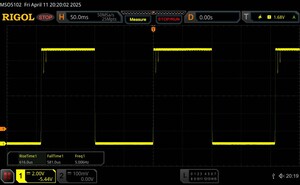
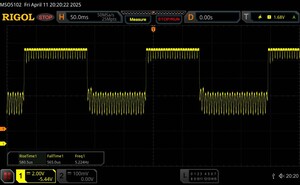
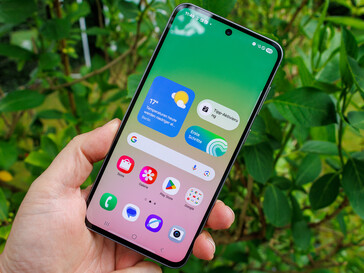




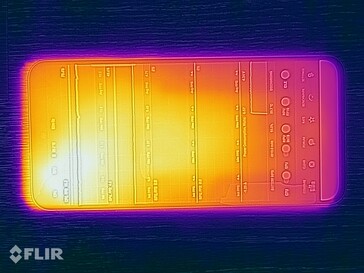
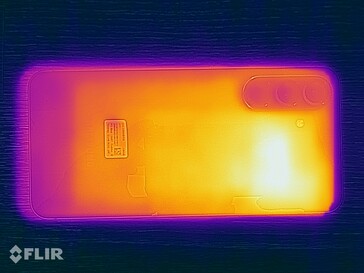
 Total Sustainability Score:
Total Sustainability Score: 





